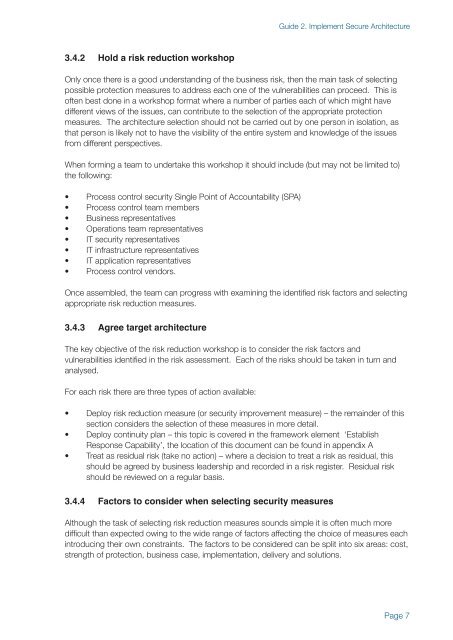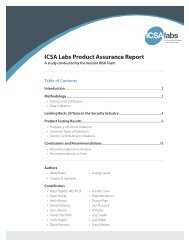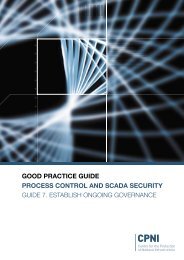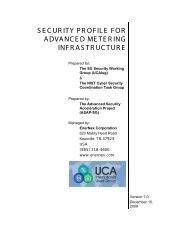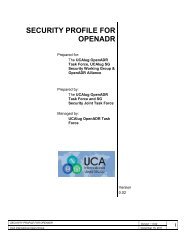CPNI - GPG - Guide 2 - Implement Secure Architecture
CPNI - GPG - Guide 2 - Implement Secure Architecture
CPNI - GPG - Guide 2 - Implement Secure Architecture
Create successful ePaper yourself
Turn your PDF publications into a flip-book with our unique Google optimized e-Paper software.
<strong>Guide</strong> 2. <strong>Implement</strong> <strong>Secure</strong> <strong>Architecture</strong><br />
3.4.2 Hold a risk reduction workshop<br />
Only once there is a good understanding of the business risk, then the main task of selecting<br />
possible protection measures to address each one of the vulnerabilities can proceed. This is<br />
often best done in a workshop format where a number of parties each of which might have<br />
different views of the issues, can contribute to the selection of the appropriate protection<br />
measures. The architecture selection should not be carried out by one person in isolation, as<br />
that person is likely not to have the visibility of the entire system and knowledge of the issues<br />
from different perspectives.<br />
When forming a team to undertake this workshop it should include (but may not be limited to)<br />
the following:<br />
• Process control security Single Point of Accountability (SPA)<br />
• Process control team members<br />
• Business representatives<br />
• Operations team representatives<br />
• IT security representatives<br />
• IT infrastructure representatives<br />
• IT application representatives<br />
• Process control vendors.<br />
Once assembled, the team can progress with examining the identified risk factors and selecting<br />
appropriate risk reduction measures.<br />
3.4.3 Agree target architecture<br />
The key objective of the risk reduction workshop is to consider the risk factors and<br />
vulnerabilities identified in the risk assessment. Each of the risks should be taken in turn and<br />
analysed.<br />
For each risk there are three types of action available:<br />
• Deploy risk reduction measure (or security improvement measure) – the remainder of this<br />
section considers the selection of these measures in more detail.<br />
• Deploy continuity plan – this topic is covered in the framework element ‘Establish<br />
Response Capability’, the location of this document can be found in appendix A<br />
• Treat as residual risk (take no action) – where a decision to treat a risk as residual, this<br />
should be agreed by business leadership and recorded in a risk register. Residual risk<br />
should be reviewed on a regular basis.<br />
3.4.4 Factors to consider when selecting security measures<br />
Although the task of selecting risk reduction measures sounds simple it is often much more<br />
difficult than expected owing to the wide range of factors affecting the choice of measures each<br />
introducing their own constraints. The factors to be considered can be split into six areas: cost,<br />
strength of protection, business case, implementation, delivery and solutions.<br />
Page 7


